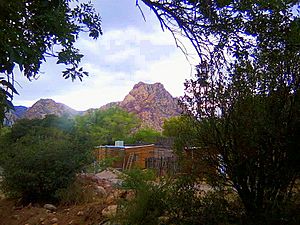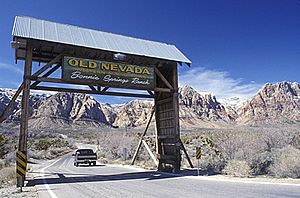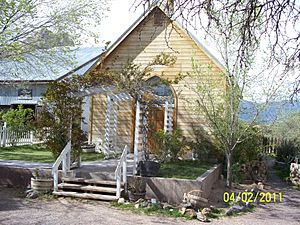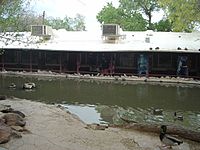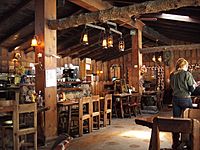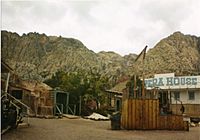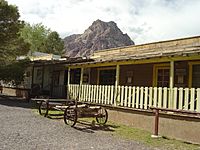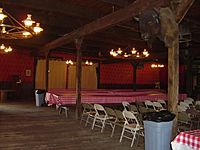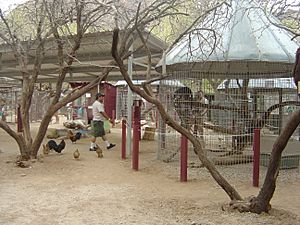Bonnie Springs Ranch facts for kids
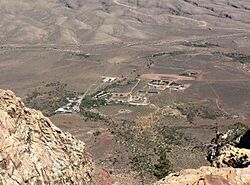
Bonnie Springs, seen from the Spring Mountains in 2006
|
|
| Location | 16395 Bonnie Springs Road, Red Rock Canyon, Clark County, Nevada, United States |
|---|---|
| Coordinates | 36°03′34″N 115°27′15″W / 36.059405°N 115.454048°W |
| Opened | 1958 |
| Closed | March 17, 2019 |
| Attendance | 130,000 (2007) |
| Area | 63.86 acres (25.84 ha) |
Bonnie Springs Ranch was a popular place to visit near Blue Diamond, Nevada. It had a fun replica of an 1880s western town and a zoo. This ranch covered about 64 acres in the Mojave Desert. It was located below the Spring Mountains in the Red Rock Canyon area. This spot was about 20 miles west of Las Vegas. The ranch had a natural oasis because of the fresh spring water that came up from the ground.
The ranch started way back in the 1840s. It was a stopover for wagon trains traveling to California. A woman named Bonnie McGaugh bought the ranch in 1952. That's how it got its name, Bonnie Springs Ranch. By the mid-1960s, you could go horseback riding and eat at a restaurant there. Old Nevada, the western town, opened in 1974. The zoo and a motel were added in the 1980s. In 2019, plans were made to close the ranch. It would be replaced with new homes, a restaurant, a motel, and an event barn. Bonnie Springs closed on March 17, 2019. The new area is now called The Ranch at Red Rock.
Contents
A Look Back: Early History
The ranch site is about 4,000 feet high. It has natural springs that were important to the Paiute people for hundreds of years. They lived in small areas in the rocky cliffs nearby.
The site became a watering stopover in 1843. Wagon trains used it when traveling to California on the Old Spanish Trail. There was a ranch house there. In 1846, General John C. Frémont stopped at the springs. He was on his way to Alta California and needed to get ready for his trip through Death Valley. By 1860, the site had a blacksmith shop and a small cabin.
Bonnie Springs Ranch: How it Grew
Bonnie Springs Ranch was named after Bonnie Levinson. She was born Bonnie McGaugh in 1921. Her father was a western film actor. When she was young, Bonnie was a dancer and showgirl in Las Vegas. She also toured as an ice skater with Sonja Henie. In the 1940s, Bonnie and her mother had a turkey farm in Twentynine Palms, California. Bonnie would deliver live turkeys to restaurants in Las Vegas.
In 1952, Bonnie McGaugh delivered turkeys to a friend. This friend owned a diner in Las Vegas and a ranch in Red Rock Canyon. The friend showed Bonnie the ranch. Bonnie loved the mountain views. She leased and then bought the ranch that year. The ranch was 115 acres and had a broken-down bar and a three-room house. Bonnie lived there from then on. Bonnie Springs Ranch eventually grew to cover about 64 acres.
Bonnie reopened the bar in 1952. She ran it for 12 years without electricity. She used kerosene lamps instead. A dirt road was the only way to get to the bar. It used to be called the Red Rock Tavern and opened in 1939.
Al Levinson came to Las Vegas from New York in 1949. He met Bonnie in 1952 after she reopened the bar. They got married in 1954 and were married for 40 years. Al ran a car dealership. The bar became popular with their friends, including Las Vegas showgirls and other famous people. People from nearby Blue Diamond also visited.
In the 1950s, Bonnie added two horses to the ranch. Customers were interested in horseback riding. Later, a man traded two horses for a car at Al's dealership. The couple eventually had six horses. Bonnie Springs Picnic Ranch got its business license in 1958.
By 1962, the ranch had a swimming pool. A stable for horses was added in 1963. A restaurant opened in 1964. During the 1960s, Al Levinson planned to build homes on 34 acres near the ranch. This plan included an airplane runway for homeowners. But the whole project was canceled. By 1966, Bonnie Springs Recreation Ranch had picnic areas and playgrounds. It also had 28 horses for riding. Bonnie Springs became popular with Las Vegas families. It was not very well known to city tourists.
In May 1974, a western town replica called Old Nevada was added. The next month, a fire at the ranch destroyed a barn and a trailer.
Businessman Howard Hughes owned the land next to Bonnie Springs. Before he died in 1976, Hughes wanted to buy Bonnie Springs. But Bonnie Levinson said no to his offer and others. A zoo was added to the ranch by 1985. In the mid-1980s, Al Levinson had a disagreement with Clark County officials. It was about who would pay to fix a flood-damaged road to the ranch. Al sued the county to fix the road. The county then did not want to give him a permit for a motel. In 1986, Al got a permit for a 150-room motel. A 50-room motel was built in 1989.
Bonnie and Al's children, Alan Levinson and April Hopper, took over the ranch. This happened after their father Al died in 1994. In 2004, the ranch had about 8,000 visitors during holidays. In 2005, Alan Levinson planned to build 17 homes as part of Bonnie Springs. Each house would be on two acres. This project was planned for 34 acres east of the ranch. There were no plans to close the ranch. Environmental groups like The Nature Conservancy and the Sierra Club thought the project would not harm the area much. However, it was never built.
In August 2005, the ranch had 86 employees. About 32 of them lived at the motel. On Saturdays, the ranch had 1,000 to 1,500 visitors. On Sundays, it had at least 2,000 visitors. Most visitors were from Nevada or were tourists. In 2006, Bonnie Springs had the only restaurant and lodging in the Red Rock Canyon area. In 2007, the ranch had 130,000 visitors each year. Bonnie Levinson died in January 2016 at 94 years old. Alan Levinson and April Hopper kept running the ranch.
New Plans for the Ranch
In early 2018, the ranch was put up for sale. Joel Laub and J. Randall Jones bought the 63-acre property. They announced their plans in January 2019. They wanted to build about 20 custom homes. They also planned new things like a restaurant, a motel, and an "event barn" for weddings. The ranch's western town and zoo would be taken down for the new development. The new owners were not licensed to run a zoo. The construction would not start until all the ranch animals found new homes. The Levinson family helped with this. They said they were ready to retire.
Joel Laub was also part of a local Nature Conservancy group. He wanted to develop the land in a way that protected the environment. He said the old ranch was "not environmentally friendly." For the new project, he worked with wildlife experts. They planned to use native plants and help desert animals move around. Laub also planned to fix the natural springs on the property. These springs would provide water for plants and animals. The project would have 8.5 to 10 acres of public space. The rest would be for the homes. Each home would be on two to three acres. The houses would be designed to fit in with the Red Rock area. They would not be huge "McMansions." Each house would be a maximum of 5,000 square feet. Most of the existing trees and plants would stay. The ranch's parking lot would be replanted with native plants. The houses would be hidden from the main road by landscaping.
The sale was expected to be finished in March 2019. Then, demolition would begin. People were upset about the plans. Two petitions were started to save the ranch. They wanted it to be a historic landmark. But no government groups had enough money to buy the ranch. Within two weeks, the petitions had over 51,000 signatures. Jones understood that people were "emotionally attached to Bonnie Springs." He hoped the change would make everyone happy in the end.
Later in January 2019, it was announced that someone wanted to move the western town to a new place. This way, it could still be an attraction. A local woman, Sharon Linsebardt, wanted to move the wedding chapel. She had a farm animal sanctuary in Las Vegas. The Levinsons agreed to give her the chapel if she paid to move it.
In February 2019, the Clark County Planning Commission approved the new plans. This included 22 homes and a bed and breakfast. Some people were still against it. They thought the homes would "fundamentally alter the character of Red Rock." The commission said the project would not lead to more homebuilding in the area. They believed the new project would help restore the natural environment.
Bonnie Springs closed on March 17, 2019. There were long lines during its last two days. The sale was finalized on April 2, 2019, for $25 million. By then, all the ranch animals had moved to other zoos. An auction of Bonnie Springs items happened later that month. Demolition of the motel and restaurant started in June 2019.
In February 2020, the new project was named The Ranch at Red Rock. The new owners could not use the "Bonnie Springs" name. Twenty residential lots went on sale. They were 2 to 4 acres each and cost millions of dollars. The homes would be in a gated community. Owners would build their own homes. Rules were made to limit home sizes and help them blend in. Many of the old Bonnie Springs buildings were torn down. The Old Nevada buildings were still there for a while.
Fun Things to Do at Bonnie Springs
The two-story Bonnie Springs motel had a swimming pool. Its 48 rooms had different themes, like Chinese or American Indian. Some rooms even had a jacuzzi. The ranch also had the Red Rock Riding Stables. You could go pony or horseback riding there. The ranch had an outdoor arena with bleachers for events like rodeos. On weekends, a small train took visitors from a big parking lot to the motel and Old Nevada. In 2018, the ranch planned to offer helicopter tours of Red Rock Canyon.
Food and Drink
Before the restaurant opened, Bonnie Levinson would serve biscuits and coffee to friends. Then she started cooking for her ranch hands. Soon, people heard about the good food and started coming for meals. This led the Levinsons to open a restaurant. They made the 1840s ranch house into a restaurant and bar. It opened as the Bonnie Springs Steak House in 1964. Bonnie Levinson made the furniture and helped build the big fireplace.
A pond was built in front of the restaurant. It used to have fish that you could catch. The restaurant would then cook your fish for you. By 1980, the pond had ducks, geese, and turtles.
The bar became famous for its collection of neckties hanging from the ceiling. Dollar bills were pinned to them. Al Levinson started this tradition. He didn't like ties in the restaurant. So, he would take any tie that came in and pin it to the ceiling. People later started pinning money to the ties.
In 2001, all the money from the ceiling, which was $18,744, was given to local firefighters. This money had been collecting since 1991. The Levinson family wanted to donate it after the September 11 attacks. The ties on the ceiling kept collecting money. This money was given to different nonprofit organizations. The restaurant also served a big bison burger.
Old Nevada: The Western Town
By 1969, the Levinsons planned to build a western village. In 1972, they started building Old Nevada. This was a group of buildings that looked like an 1880s mining town. Al Levinson had wanted to build it for years.
They did a lot of research to make the buildings look real. The buildings were made of old wood. Al Levinson found this wood to make them look like old mine town buildings. The design of Old Nevada's Methodist wedding chapel was based on a chapel in Belmont, Nevada.
Al Levinson collected thousands of old drawings and pictures of buildings. He used them to design Old Nevada. Nevada mining camp ruins also helped inspire the town. Even though the buildings looked old, they were built with modern safety rules. They even had air-conditioning. Only restaurants and bathrooms had indoor plumbing. Other buildings had outdoor water pumps to look historical. Old telephones were fixed and connected to a switchboard. This was the only way to communicate in Old Nevada. The sidewalks were made of special wood from Oregon.
Old Nevada cost $800,000 to build. It opened on May 1, 1974, with 45 buildings. It covered about 5 acres. A restored 1881 horse-drawn carriage took people around town. Old Nevada had the Miner's Restaurant, a casino, and a small steam train. It also had a fun shootout show between a lawman and a gunman.
Old Nevada also had shops that sold old items. A western-style saloon could hold 900 people for parties. To get more visitors, the saloon had a vaudeville dinner show. It was called Bonnie's Old West Musical Revue. This show ran on weekends from May to August 2012. Later, it moved to the Plaza Hotel & Casino in downtown Las Vegas. The saloon also had karaoke and live music. In 2013, Old Nevada had the wedding chapel, the saloon, and a small schoolhouse. Staged gun fights and souvenir shops were still there. Old Nevada also had two museums. They showed local items and wax figures from the 1800s.
The Zoo at Bonnie Springs
In 1975, Bonnie Levinson took in two pygmy goats from Wayne Newton. Someone also left a sheep at the ranch. Then two deer arrived, and Bonnie adopted a wolf. Bonnie loved animals. She also had cats, dogs, chickens, and rabbits. Many of these animals were left at the ranch by owners who didn't want them anymore. All these animals made Bonnie want to build a petting zoo for kids. The petting zoo opened by 1985. The zoo was added to bring more families to the ranch.
By 1997, the zoo had bobcats, burros, coatimundi, lynx, coyotes, ferrets, hedgehogs, llamas, porcupines, prairie dogs, squirrels, turtles, and a woodchuck. Emus were also added, including one found abandoned in the desert. Peacocks and deer walked freely in the fenced zoo area. The ranch also had many horses. Bonnie Levinson raised some of the animals. Most of the zoo animals were rescued because they had been mistreated. The petting zoo had goats, deer, sheep, and buffalo. Some animals could handle the desert heat. Others had covered areas with misters and water. Animals were also given ice packs to stay cool.
In 2012, the zoo was completely redone with new enclosures. In 2015, the zoo had four full-time zookeepers and many volunteers. In 2017, the zoo had over 20 animal species. This included more than 70 peacocks. Some of the zoo's animals stayed with the Levinson family after the ranch closed. Others moved to zoos in Nevada and California.
Spooky Stories: Paranormal Activity
Some visitors believed the ranch was haunted. Tim Harrison, who managed events at the ranch, said in 2016, "We were a main stop for wagon trains. Many people died on their journey here. We think those spirits are still around." He added in 2017, "There's a little girl by the school house, and several apparitions at the opera house. You hear all kinds of stuff."
Every October, from 2008 to 2018, the ranch was called "Bonnie Screams" for Halloween. It had different haunted house attractions. In 2015, Bonnie Screams added a zombie-themed paintball game. People rode a bus and tried to shoot zombies with paintballs. A local group that studies ghosts also offered tours of the ranch's haunted areas. These tours tried to contact the ranch's ghosts. Famous people like Susan Slaughter from Ghost Hunters International sometimes joined these tours.


